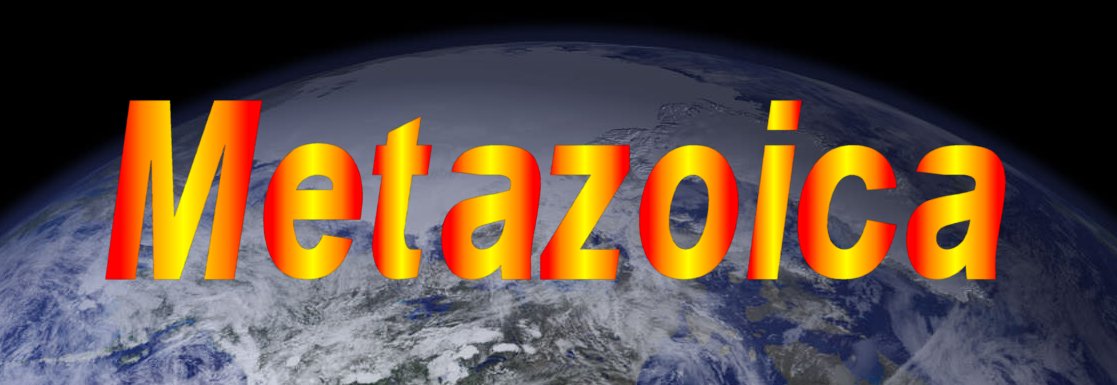Welcome to my Metazoic site! This site discusses the existence of the creatures to come along after humans will be extinct. I first became interested in a world after man when I acquired my first copy of Dougal Dixon's After Man: A Zoology of the Future in 1992. However, I unwittingly created creatures that did not exist from the time I was about 8 years old. But it was after I obtained a copy of that book (now a collector's item) that I decided to take these same creatures I created as a child and make them more realistic in an evolutionary sense. Though it may be hard for a lot of us to grasp, humans will soon become extinct. One of the biggest factors of how this will happen is the current overpopulation rate. Which is why I don't contribute to the population. I created this world with little more than mammals fulfilling all ecological niches with the help of some friends. I even gave the era of the age after man a name, I called it the Metazoic, derived from the words for "After-era" (Meta, meaning after, and zoic meaning era). We are now in the Cenozoic era. To view all the animals I have created since I began this project, you can go to the "Meet the Mammals" section of this site. To discuss your own ideas about what you think will happen in the future world, and share your ideas with others, please feel free to leave a comment.
One more thing, some of you may find this site quite offensive, and you have a right to your own opinion. But please respect my right to have an opinion too. I'm not saying there is no GOD, I believe it was HIM who got the ball rolling. But I believe after that, evolution took over. There is so much more evidence of evolution than there is of creation. Even that going on right under our noses. Other than that, enjoy yourself and visit our many links.
Tuesday, February 24, 2009
Climate Change and Temperate Plants
http://dsc.discovery.com/news/2009/02/24/climate-change-plants.html
Climate Change Can Supercharge Plant Growth
Emily Sohn, Discovery News
Feb. 24, 2009 -- Climate change might help some plants thrive -- not just because temperatures will be warmer, but because temperatures will be more variable.
As deeply frozen winters give way to more cycles of freezing and thawing, certain plants will become more productive, according to one of the first studies to consider the link, though not all plants will benefit and those that do might suffer in other ways.
"These findings illustrate that climate change will provide many surprising effects in ecosystems," said lead researcher Juergen Kreyling, of the University of Bayreuth in Germany. "Freeze-thaw cycles are just one phenomenon that is not yet understood but is rapidly changing."
According to projections by the Intergovernmental Panel on Climate Change, many places with traditionally cold winters will begin to flirt more frequently with the freezing point as the climate heats up.
Normally, a thick snow cover insulates the soil in temperate and high-latitude regions, keeping ground temperatures fairly constant. But warmer days will lead to less snow on the ground, meaning the soil is more likely to freeze and thaw many times over the course of the season.
Previous research has shown that thawing and refreezing affects nutrient levels in the soil as well as microbial activity. Kreyling and colleagues wanted to know what the shift in winter weather would do to plant life.
In the winter of 2005-2006, the researchers planted several species of common grasses and herbs in 30 plots on the outskirts of Bayreuth, where average January temperatures usually hover around negative one degree Celsius (30 degrees F). Each plot contained 100 individual plants and a buried heating wire that could artificially thaw the soil.
When temperatures dropped below freezing and stayed there for 48 hours, the team turned on the wires in half of the plots. Two days later, they allowed the soil in these plots to freeze again. Over the course of the winter, the technique added five extra freeze-thaw cycles to the three that occurred naturally.
After harvesting, drying, and weighing the plants the following summer, measurements showed that heated plots contained 10 percent more biomass above ground than unheated plots did. In a paper in the journal New Phytologist, the researchers speculated that thawing and refreezing increases microbial activity and breaks up the soil, making plants more productive.
"Winter...is a time during which the plants were proposed to do nothing," Kreyling said. "It is astonishing that they seem to be able to take up nutrients that become available during the freeze-thaw events."
Not all news was good news, though. Results showed that roots were shorter in the heated plots. The same weather conditions might be harder on other plant species, added Hugh Henry, a plant ecologist at the University of Western Ontario. And, he said, nutrients that leach out of the soil during freezing and thawing cycles most likely end up in rivers, streams, and lakes, where they cause algal blooms and other problems.
"This indicates," Henry said, "that changes in climate and more extreme climate events could potentially have fairly large effects on nutrient availability and the way plants grow."

2 comments:
Metazoica, I'm afraid I have to disagree with you here. The reason why the angiosperms rose to prominence is because they grew, bloomed, and reproduced fast. Grass grows incredibly fast, and flowers and other such plants blooms rapidly after the winter. Even with a temperature increase, it seems that in the Metazoic angiosperms would stay the same, to always try and stay one step ahead of the ravenous mouths of anacolls, abbergants, antelope, lagomerycines, other therapeds, and such.
Oh, they'd still reproduce quickly.
Post a Comment